The Rarest Sansui Project
Having a tiny little company that is just about the only place in the country restoring Sansui units, especially QRX’s, to their original glory, has its occasional perks. About 4 months ago I got a call from a nice gentleman in Chicago. He said that he had some Sansui Tube gear that he had bought new while stationed in Asia, back in the 60’s, and would I maybe be interested in the gear?
I said, “Probably”, and he proceeded to tell me about the Sansui setup he had, consisting of a CA 303, a BA 303, and two BA202’s and all the accessory crossover boards. He said he had put them away in the closet 20-30 years ago, and he thought it would be a good idea to find them a new home with someone who really cared. Kind of cleaning house, or something like that.
I replied, “Whatever you do, please don’t plug them in and turn them on. That could be a disaster.” He said he could understand that and wouldn’t do it. I asked for pictures, and he sent me a bunch. They really looked nice and original. He said they were working when he put them away. Here’s some of the pictures he sent me.
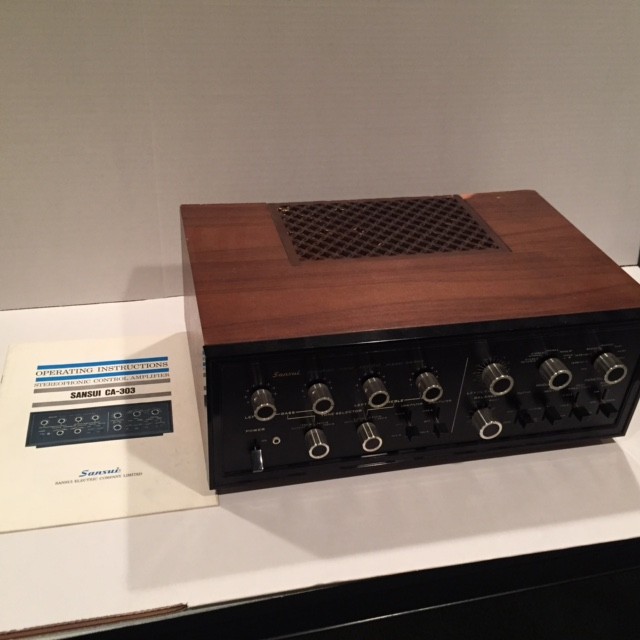
CA 303, Sansui’s ultimate and final tube pre-amp.
He also had all the documentation, along with receipts and the receipt from a repair that had been done.
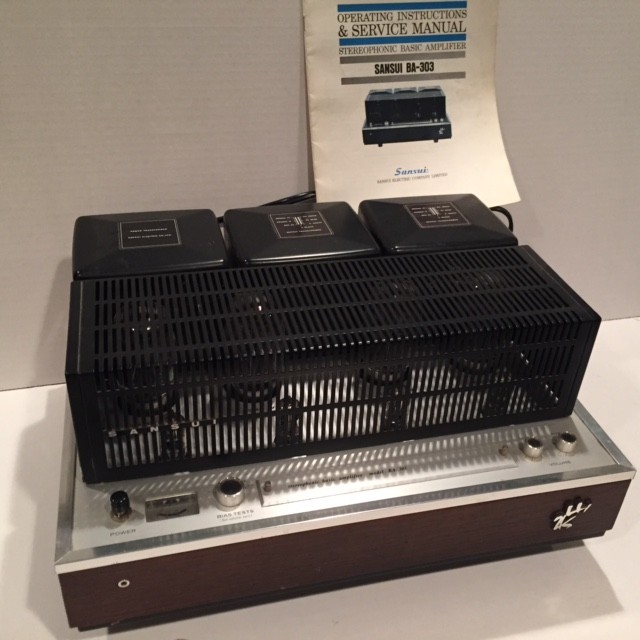
BA 303, triode mode, class AB1 amp with KT88 tubes, 35 watts per channel.
Triode Mode is quite interesting. A lot of more modern amps have the ability to switch from Triode mode to ultralinear, as it’s called. Most people prefer the sound of Triode Mode operating in class AB1. This means the amp operates in Class A at low levels, smoothly switching to Class B, which is more efficient, at higher levels.
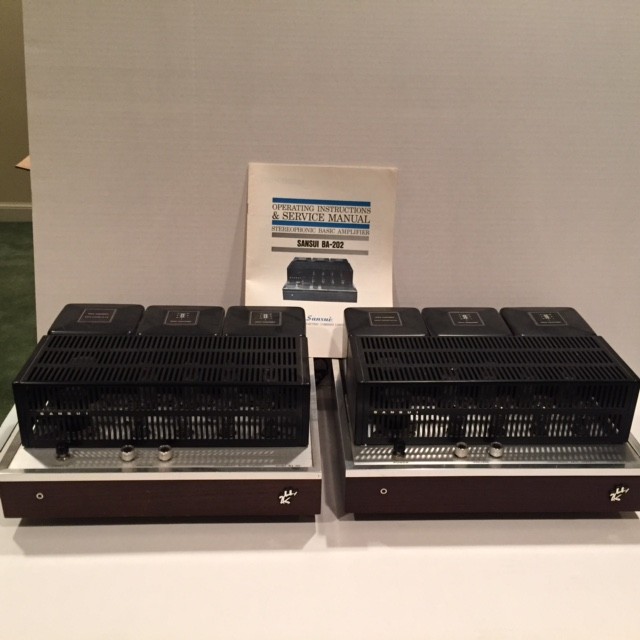
Two BA 202 amps, the 11 WPC version of the BA 303. These were designed to be the mid and hi amp in a tri-amped system, built around the CA 303.
I’m not a tube guy, and I will explain that later, but this was indeed very intriguing. If you do any research on the internet, you will find the rarest Sansui gear ever made are these exact units. They generally only exist in Japan, as they were only sold in the home market.
I think it might be possible that the transformer design in these units might have impinged, or could be construed to impinge upon transformer patents held by McIntosh at the time. In any case, solid state amps were just coming into their own, and Sansui made the decision to not market these units world wide. I imagine there was an original production run, and that was it, once they were sold. The 159c/s turnover frequency on the bass control leads me to think that. It would have been corrected on subsequent production runs.
Harmon Kardon designed their Citation II amp around the McIntosh patents. The BA303 certainly resembles the Citation II and matches it almost exactly in layout, weight, and dimensions. It has been years since I heard one of these, or a McIntosh, but I would put the sound, in its warmth and “tubiness” somewhere between the two.
The CA303, a tube pre-amp, had a solid state electronic crossover on its output, and the idea was you would electronically cross over the sound spectrum into lows, mids, and highs and bypass the crossovers in the speakers using the three amps. I will get to that later.
The BA 303 was a 35 watt per channel amplifier, using KT88 tubes, with giant, oversize, power and output transformers. It, and the BA 202, were “Triode” amplifiers, using the KT88’s in triode mode. This was a new design to me, not “single ended” but a regular push pull configuration, with only the cathode, grid, and plate utilized. Because it is in Triode Mode, only 35 watts is available, instead of the usual 60 watts or so you can get out of a pair of KT88’s.
The BA 202 was the same idea, with s a slightly simpler and smaller design that put out 11 watts per channel, about 4.5 db less than it’s big brother. It’s most distinguishing characteristic, aside from the sound quality, is that it uses four 6RA8 output tubes, which seem to be the very definition of the word “unobtainium” More on that later.
The owner wanted me to make him an offer. I had no idea what they were worth. I went on Audiokarma (AK) and asked for advice. Several people replied, saying that there had not been any of those models for sale in the US for over 3 years. I found a listing for a BA202 that had been for sale on a Canadian news group about 4 years ago. That was all I could find.
The AK guys also said that these were worth a lot in Japan, but it was very difficult to sell into that market. One person said that the whole setup should certainly equal or exceed the value of a completely restored AU111. Their ultimate advice was to figure out what I was willing to pay, and not go over whatever my maximum was.
I figured out just what we would charge to restore all these units, subtracted that from what I sorta thought they would be ultimately worth, and had a good idea of what I was willing to pay. If these units were as good as everything I had dug up about them on the internet, and my friends on AK said, I would be keeping them for myself.
I called the gentleman back and we agreed on a price that I was comfortable with. I then got a company in Chicago, which I found on the internet, Craters and Freighters, to safely pack the units onto a pallet, so they could be sent motor freight from Chicago to Eugene, Oregon, or as we affectionately know it, Crazytown. About 160 pounds of Sansui vintage hollow state was on its way to me.
Everything arrived in good condition, and I put them aside to be a winter project.
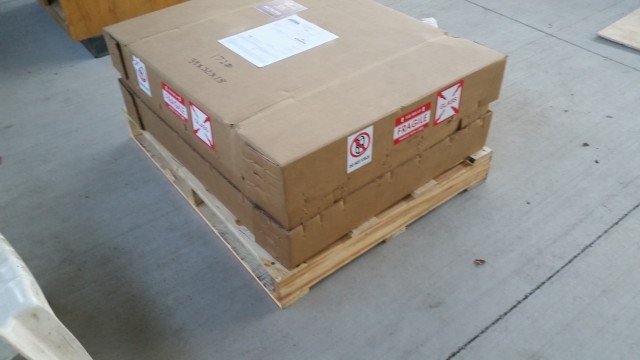
A big truck delivered this to my door about a week later. Over 200 lb including packing and pallet.
The shipping from Chicago was quite expensive. I had heard of these guys before, and to me it was worth it. What would be the point to get these units delivered, in banged up condition? Not the way I wanted this story to go.

Excellent packing job. The crating company is called “Craters and Freighters”. I saved the box. Everything was in perfect condition. Expensive shipment.
Here is an interesting history of Sansui Tube gear. These units are the last three described on the page here.
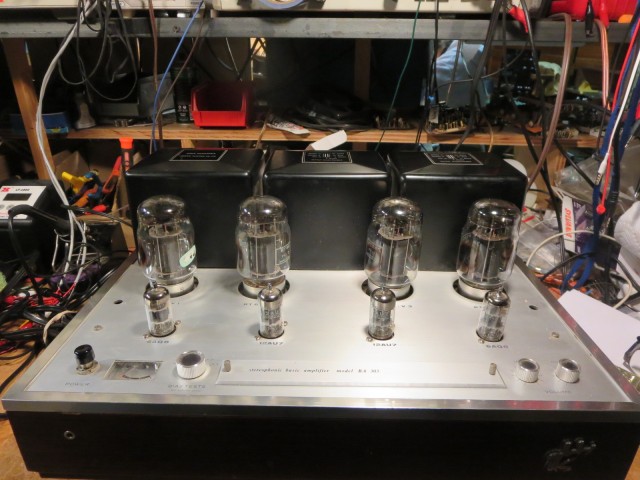
The BA 303
Early December 2015… and… we are well into our typical NW wintertime weather of rain, rain, and more rain, so with some relish, I got started on the project. I decided to do the BA 303 first, as it is indeed the most imposing of the bunch to look at, 66 lb of Sansui iron.
As was mentioned before, none of these units will be powered up before their restoration. That’s always a good idea for gear that has been sitting for a long time. After 20+ years, you just don’t know. A cap could blow up, and/or a tube or transformer damaged. Don’t let your curiosity get the best of you, even with a variac.
A 50 year old electrolytic cap could do anything from acting like a dead short to completely open with no capacitance. A burned out xfmr winding in one of these units could result, and that might just be the end of that restoration.
The first thing with any tube restore, is to line up the parts. Finding what you need can be challenging. There are 4 can capacitors under the chassis, and without too much difficulty, I found replacements, and also got enough parts to do all 4 units. Surprisingly, the hardest can caps to find replacements for were in the CA 303.
Wide open spaces underneath the BA 303. The hardest thing was physically removing and remounting the can caps. They were mounted on a sub-chassis piece that did not want to move very much because everything else mounted on it was already wired in.
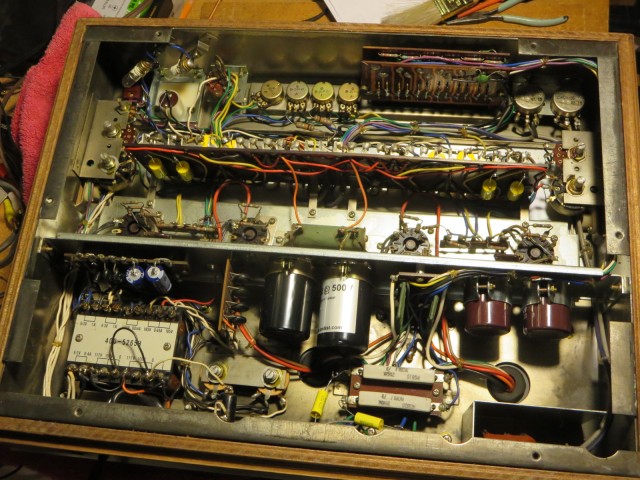
Lots of room underneath. Sansui did a beautiful job of arranging all the parts. There are 4 can type caps mounted with clamps. The original clamps all had their clamping screws on the underside.
The frequency response of the BA 303 is listed as 10-50,000 cycles. In their literature, Sansui said that this design gave really good bass response, with excellent definition, no boominess
. Since this is important to me, I increased the size of the inter stage coupling capacitors, but not too much… tube amps can become unstable on the low end.
With an ohmeter, I checked all the resistors. There were a few carbon composition resistors, but most were some kind of high quality resistor with caps on each end. Metal film, maybe? Did they make metal film resistors in the 60’s? I’m afraid I don’t much about the history of basic components.
It’s quite common, especially if things run hot, for old resistors to drift in value as they age. Every one I checked was within 5% of value, so I ended up not changing any.
I have restored a few pieces from the 50’s. There’s a picture of a National SW receiver on one of the Shop Action pages, and that one needed over half the resistors replaced. I guess there was a big increase in quality from the 50’s to the 60’s.
I checked out the KT88’s on our tube tester. They were very close to the middle of the acceptable range. I bought a set of 4 matched brand new Mullard’s and decided not to put them in but to continue with the originals, which are also Mullard’s. They weren’t cheap, but they will probably cost more next year and every year after that.
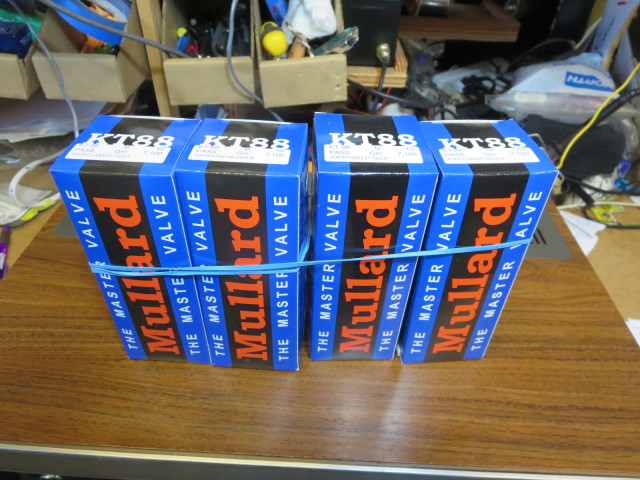
New matched set.
When I was done, I hooked it up to the big speakers in the shop. I spent two hours or so playing with the bias, gradually setting it higher and higher, until I got to the factory setting. It ran amazingly cool with full bias. Every other tube amp I have set up runs so hot with full bias, I would always set it a bit less.
I played the BA 303 loud in the shop for almost two hours, and the output transformers stayed cool to the touch. The power transformer got slightly warm, but only noticeable as such in comparison to the output transformers. I drove it directly from my Ipod, on which I have a lot of music recorded at high bit rates.
The sound was very impressive. Very clean and non fatiguing, with excellent low end, the best low end I ever heard from a tube amp. I was kind of withholding judgement though, until I got the CA 303 working. After all, that is the pre-amp it was designed to work with.
Most impressive was the feeling of quality. It seemed that this amp was designed and built with a cost no object kind of engineering. Everything about it is solid, overbuilt, and over spec’d. The completely cool running transformers are amazing. I have currently a Fisher X202-C , a couple Fisher 800’s and an Eico ST70 and all of these, the transformers get so hot you can hardly touch them. I can only bring myself to play those units with a cooling fan mounted on the shelf behind.
BA 303: About 15 hrs of time in the shop to restore.
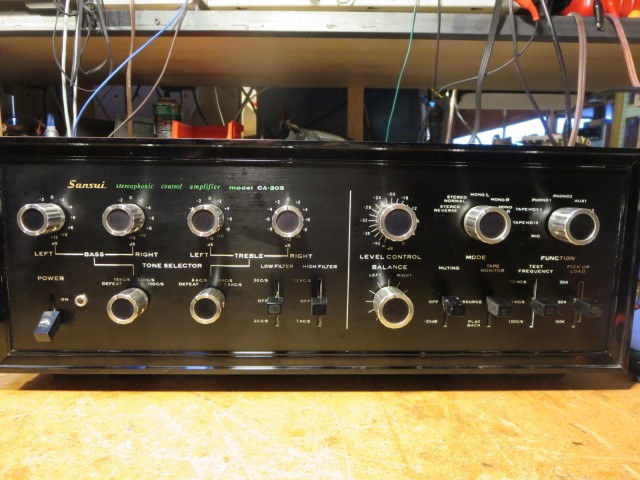
Sansui CA 303, restored and tested
The CA 303
OK, now to finish the other half, or one fourth, depending on how you choose to look at it. Sansui marketed these units as a complete tri-amped system. More about that later. However the pre-amp has a standard non crossed over output, and I would use that to drive the BA 303 at least at this point in the total restoration.
The CA 303 was produced in 1967, right after, but pretty much concurrent with the AU111. The styling is very similar to the AU777. The front panel is engraved, not silk screened… expensive. It also has a stepped volume control that feels different than anything I have ever felt on a piece of stereo gear.
The volume pot has a metal cover and one of the first things I did was to take the cover off the rear section. This is a stepped volume control with gold contacts and multiple resistors. The only place I have seen these before was in pro gear, like a broadcast mixing console. I don’t think these stepped pots are available anymore. If they were, or if you found a used one, they would probably cost $150-250 each. Quality.
The reason for the stepped control is that normal potentiometers are pretty low tolerance devices. In order to control volume, they have to be made with a logarithmic resistance curve, and typically that curve will vary by 10-20% or more from one section to the next. That means that your center positioning, or where you should have the balance control set will need to be different at different loudness settings. The most variation tends to be at the beginning of the rotation, at low levels.
A stepped control will maintain the stereo center setting at all volume levels.
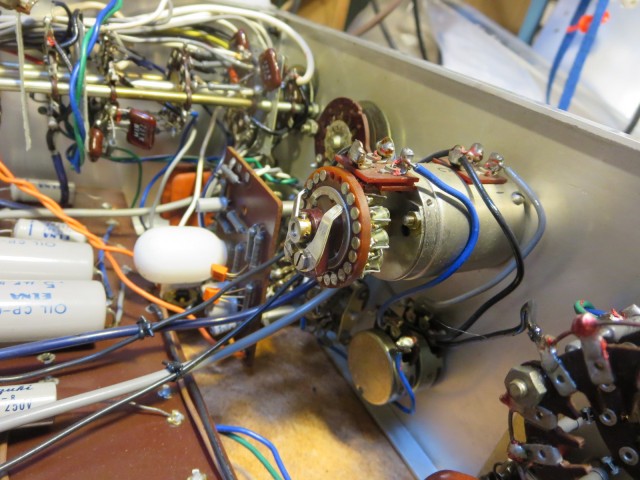
Rear cover off this two gang volume control. Front cover off requires disassembly. This is pro audio quality from the 60’s. I don’t know of another piece of home audio gear, ever, that has one of these. Light bulb is part of the test oscillator. Oil caps to left were replaced with polypropylene.
Sansui made a big deal in their marketing that they were trying to equal or better the top of the line Marantz 7. The quality was evident throughout.
The power supply was the hardest part of this restore. Point to point wiring, with a whole bunch of resistors and caps crammed into a small space. Two of the cans were just a single cap, 2000uf/50v, and there was no way I could find a cap that would be big enough to fit where the cans were A replacement cap was much smaller and I just left those two cans mounted and put the replacements in the already crowded space with the other point to point wiring.
Adding to the power supply complexity is the fact that the tube heater supply is rectified and filtered for an absolute, no humm noise floor.
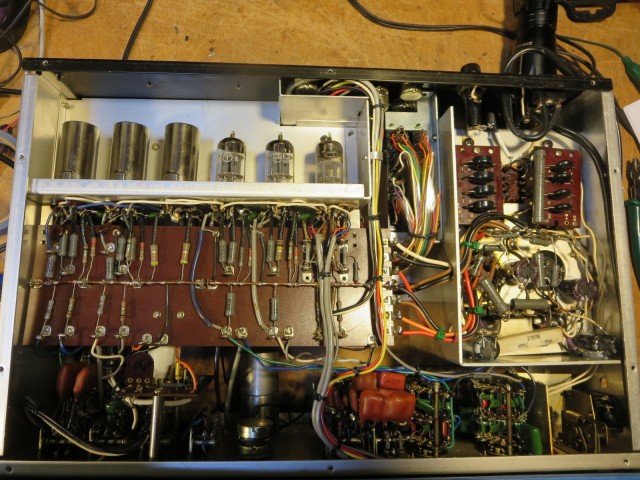
Bottom cover off. Power supply section is on right.
I spent several hours going over the schematic and getting to the point where I understood how it worked. My reason for doing this is because… Back in the 60’s, good low end response meant flat down to 40 hz or so. Manufactures might claim better response, but usually it wasn’t there, response would start to roll off between 30-50 hz on all but the most expensive gear.
And that made perfect sense. Practically the only source material back then was the LP record, and that went down to about 40 hz. There were a few recordings that had 30 hz information on them, but very rare. A special cutting had to be done as the 30 hz wiggle in a record groove was so big the grooves had to be made wider.
Today, it seems like the low cutoff for today’s source material is 16-20 hz or so, the limits of hearing. And there are plenty of speaker systems that will get you there. My personal opinion is that if you want an amplifier to have really fantastic low end, it must be flat in response down to 4-5 hz. Such an amp will sound like a DC amplifier, ie. like a Crown DC300A.
Such an amplifier will be different in several respects. One of them is that with a decent speaker system, you will tend to run with no bass boost, or maybe just 2 db of boost or so. No loudness either.
All the coupling caps in the signal path of an amplifier contribute to low end roll off. You can easily calculate what size coupling cap to use for an exact roll off frequency with any circuit. The problem is that lots of different stages are cascaded together in the signal path from source to speaker output. AND, these roll off curves interact to make a new roll off curve and corner frequency that is not apparent from the individual components. You can easily have 6-10 of these in series in a design like this.
Long story short, I increased the value of some of the caps in the signal chain, where I thought it might enhance low end response. The output cap went from 0.5uf paper/oil to 2.2uf polypropylene. There is no way to know what it sounded like before, but it now has phenomenal low end. And of course that ‘to die for’ musical, clean sound that tubes are famous for.
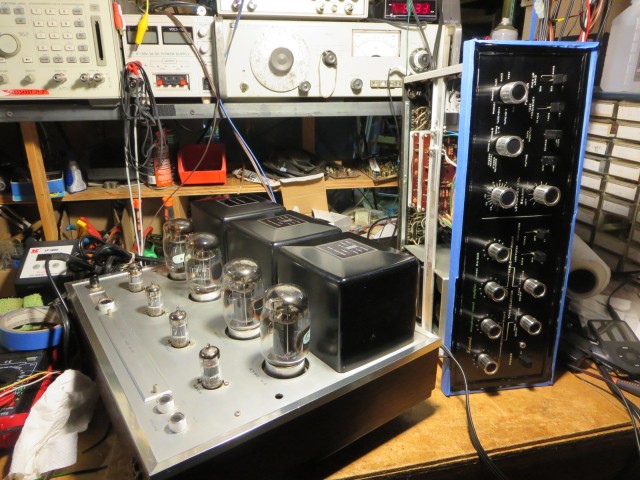
First crowded bench test. Two exceptional vintage pieces finally playing together after 25 years in a closet. Blue tape is to protect the edges of the CA 303. Stunning sound on our big shop speakers. The best tube low end, ever.
We have a very precise RIAA adapter box. You can plug a line signal into it, and it comes out the other side at phono level, with a perfect RIAA curve, with less than 0.2 db variation. We use this to check phono inputs. It works very well, cause you can listen to music on the aux input, then plug this adapter in, and listen to the same music through the phono input.
I suspect this CA 303 probably has one of the best phono pre-amps ever made. We don’t play records in the shop, and I don’t in my personal listening room, but after many, many phono tests with our adapter, you start to get a feel for this. First of all, most phono equalizers that make the RIAA curve into music again, are not accurate. You can usually hear a difference in frequency response and a difference L to R.
The CA 303 was so good on the curve, I couldn’t tell the difference.
Justin is really into vinyl and has a huge record collection, and I wouldn’t be surprised if this thing ended up at his house for a while, doing what it was designed to do.
The other thing that’s really impressive are the tone controls. First of all, they can be switched completely out of circuit. Turnover frequencies are selectable. I can’t help but wonder if there wasn’t some mistake when the engraving was done, probably to a bunch of front panels in quantity, because the three frequencies for the low control are 159 c/s, 240 c/s, and 300 c/s. That’s cycles per second to you youngsters out there. 159?
My criteria for tone controls is that they shouldn’t seem to alter the sound. They should just seem like the bass is louder, or more high end, not like you’ve turned it up. There are quite a few Sansui models that have achieved this level of quality, and some that haven’t also.
Just like in the BA 303, the original, 50 year old, tubes checked out OK, and I decided to use them.
Alright, so… at the beginning of this, I said I am not a tube guy. What I meant by that is that I love the sound of tubes, particularly on such things as well recorded pop vocals from the 50’s and 60’s. The thing I don’t like is the low end. I’m a big fan of music with low, low bass material, that has texture, and hits you in the gut. In the past, I haven’t heard that with tubes. And the other thing I didn’t like was just how hot everything ran. I always added fans.
This setup, the CA 303 and its intended amp, the BA 303, blows my whole tube prejudice right out of the water. The low end of this combination is as good as any SS setup I have ever heard, and then you get the rest of the spectrum rendered up as only tubes can do it.
I listened to Bela Fleck– UFO Tofu, and Cosmic Hippo. These recordings have some of the best dynamics, and best recorded low end material available anywhere. This CA 303/BA303 combination delivered this material absolutely as good as anything else I have ever set up and heard. Vocals are open and effortless. Cymbals seem to shimmer and sound like the real thing. To say I like these two units would be an understatement.
Now there is a new problem in my listening room. How do I get the quad sound coming from the QRX999 to utilize these two pieces of gear? I don’t know where this will lead, but it certainly makes it fun.
CA 303: About 25 hours in the shop to restore.
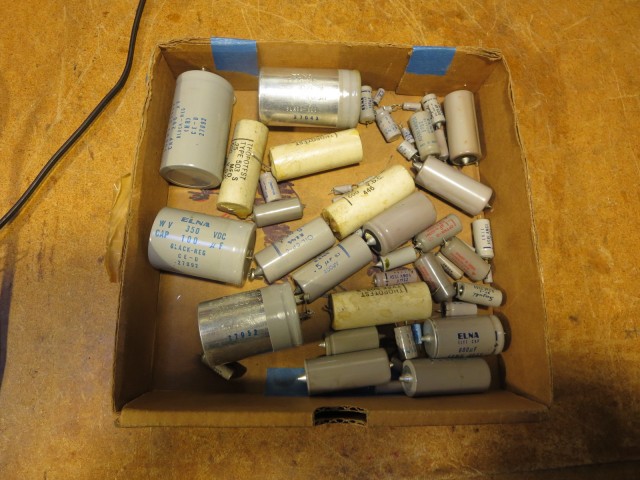
50 year old electrolytic and oil capacitors.
The Truth About Tubes
In my opinion it’s not just tubes, but even more importantly, transformers. The reason the BA303 has the low end it does is not because of the KT88’s. It’s because of the gigantic output transformers, that have so much iron in them, and the thick gauge wire coils inside that have resistance so low the bias current produces no heat.
Sansui started as a transformer company. They had the expertise and manufacturing know how to design and build what might be the best audio output transformers ever made. I’m certainly feeling that way. I would sure enjoy getting my hands on one of the big McIntosh tube amps to make a comparison.
We talk about tube audio, well… it should be ‘tube & transformer’ audio.
Stay tuned. More to come:
The BA 202
Feb 25, 2016… Ok, I have gotten one of these rebuilt. After listening for a day, I would have to say it is every bit as good as the 303, if not better. To me it seems the spaciousness, musicality, that kind of essence of what you experience with emotional and moving music, is a little better, if I thought that was possible, than the 303.
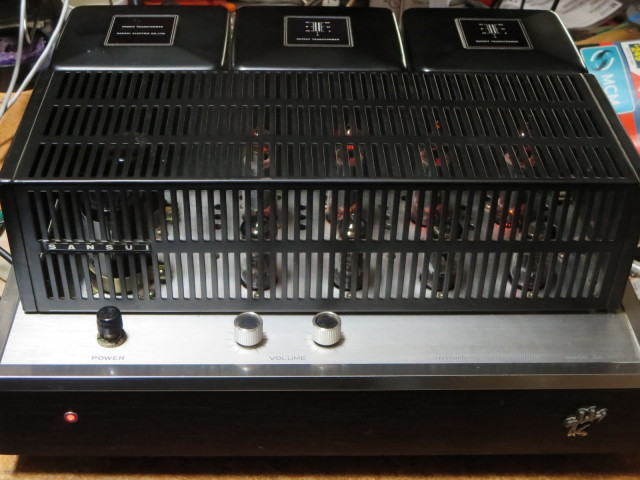
BA202 with protective cage installed. Probably the biggest little 11 wpc amp ever made.
Anyway, the details…
Very easy recap and restore. Of course, I am starting with near perfect, unmolested units to begin with, for this whole project, and that does limit the possible problems. The power on/off button was a little sticky, but some Corrosion X fixed that in about an hour. Now the push button operates like new.
I checked out the tubes and they measured right in the middle of the range on my high end Heathkit tube tester. There were no settings on my tester for the 6RA8, but more on that in a minute.
As I did on the other units in this project, I increased the size of a few of the coupling caps. By my calculations, the most bass restrictive one would be the input coupling cap, connected to the wiper of the input volume pots. It was a 0.05Uf and I increased it to 0.1.
A lot of these caps are Suzuki PIO (paper in oil) caps, and they do not have the best reputation for holding together over time. I’m very glad to be changing them out.
The units came with two genuine original service manuals for the BA202, in English, no less. The manual for the BA303 is in Japanese, and the bias settings are easy enough to decipher, but having an English version for this amp is a bonus. The bias settings are listed as 36-38 ma, measured across each transformer winding, essentially shorting out the transformer to make the measurement.
Between the cathode and ground of each of the output tubes is a 68 ohm resistor, and they all measured at 67 ohms. I am always leary of taking current measurement where high voltage supplies are involved, as there are just too many chances to have a probe slip or something, and usually… blow the fuse in your meter.
So, I just calculated the voltage drop across those cathode resistors with the specified current, and set the bias that way. It’s remarkably stable throughout the warmup process, and believe it or not, the original settings were almost all spot on. That’s after 50 years, and about 25 of those years setting in a closet. Sansui, you made quality products.
I also added an inrush current limiter, a thermistor, on the AC line input. Increases tube life.
Alright… it powered up and worked perfectly from the get go. As I mentioned in the beginning, like wow for the sound quality. So how about the reduced power, and what did the low end sound like? I have been playing this amp through our shop speakers, which are about 90db efficient. This amp is really only 4.5db less than the BA303…
The power difference was noticeable. The BA303 would run the shop system with heavy bass content material to what was for me, an uncomfortable level. The BA202 would play as loud as I would normally ever run the system, which probably is about 4.5db less.
With a pair of high efficiency speakers, like some Klipsch’s or others of that type, This amp would be all that’s ever needed. I used to have a pair of Klipschorns, and this amp would probably be just about the perfect amp for them.
The low end was phenomenal, just like with the BA303, it seemed to go right down to the lower limits, with very good detail and texture. I have never owned an 11 watt per channel amp before, or ever even tested one, but this thing blows away whatever prejudice I may have had about “low” power.
As I mentioned above, tube amplifiers (hollow state) are really all about transformers. McIntosh built their whole company on a patented design for their output transformers. They weren’t in the transformer business per se’, but Sansui was. That was their business, they built millions of transformers of all types. They only got into hifi stereo because the owner of the company was an audiophile, from the early 50’s on. While he was running the company, every single design had to be auditioned by him and approved by him, before it could be produced. That’s why even their cheapest amps are near audiophile quality.
Transformer design is probably one of the most difficult challenges in the whole field of electronics. There must be at least 15 variables in any design, with complicated math to make them work. Of course, that has been worked out and there are programs to do it on computer, but back then, not so much. It was a lot of math for some engineer.
And… just like the BA303, the transformers run completely cool to the touch, maybe just a little warmer than the BA303..
If there was any company in the world ever in the position to build the finest tube amplifiers ever made, I think it was Sansui. Their technology evolved into the 60’s and culminated with the AU111 integrated amplifier, which is considered about the best integrated ever made. Right after the AU111 they made the CA303/BA303/BA202 series as the ‘cost no object’ culmination of their journey into tube design.
The Solid State stereo juggernaut was exploding at that time though, tubes were old hat, and they wisely didn’t sell these models anywhere but in the home market, and probably very slow sales at that. Here we are 50 years later, today, and these amps are finally getting the recognition they deserved. The re-issue of the AU111 was a huge success, just try buying one of them on the used market. You can almost buy a car for the price of one…
Ah yes, as promised, the straight dope on the unobtainable 6RA8 output tube… Friends on Audiokarma told me these tubes were occasionally available in Japan. They show up occasionally for $75/pr, and these are used, no guarantees.
Turns out that the 6RA8 is virtually identical to the ubiquitous EL84/6BQ5/7189. These are 3 different tubes with slightly different power and dissipation ratings and longevity. There is also a fourth tube that is the same and is made in Russia, designated the 6P14P, and has the highest ratings of any of them.
The Russians perfected their tubes, and gold plated the grid and screen grids in this tube, mainly because of military use and longevity. This tube was the standard audio amplifier tube for practically everything made in Russia. It is considered the best EL84 type available, with silky smooth extended highs, and at least another 10-20% power dissipation. Many high end tube amps being made today use the 6P14P.
I found a seller in Ukraine, on ebay, with a perfect 100% feedback rating, with matched pairs and quads of these tubes, supposedly from the Reflektor plant. I got two quad sets of his absolutely best tested and matched tubes.
The pinouts are not the same, so I am going to convert one of these BA202’s to the 6P14P and then compare to the original 6RA8 tubes. That will be the next step in this project.
Tri-amping With The CA 303
